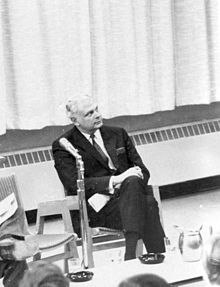Paul Hellyer
|
The Honourable Paul Hellyer PC |
|
|---|---|

Paul Hellyer, c. 1969 (age 46)
|
|
| Minister of Transport | |
|
In office 19 September 1967 – 30 April 1969 |
|
| Prime Minister |
Lester B. Pearson Pierre Trudeau |
| Preceded by | Jack Pickersgill |
| Succeeded by | James Armstrong Richardson |
| Minister of National Defence | |
|
In office 22 April 1963 – 18 September 1967 |
|
| Prime Minister | Lester B. Pearson |
| Preceded by | Gordon Churchill |
| Succeeded by | Léo Cadieux |
| Member of the Canadian Parliament for Trinity |
|
|
In office 1958–1974 |
|
| Preceded by | Edward Lockyer |
| Succeeded by | Aideen Nicholson |
| Member of the Canadian Parliament for Davenport |
|
|
In office 1949–1957 |
|
| Preceded by | John Ritchie MacNicol |
| Succeeded by | Douglas Morton |
| Personal details | |
| Born |
Paul Theodore Hellyer 6 August 1923 Waterford, Ontario |
| Political party | Liberal → Canadian Action |
| Spouse(s) | Ellen Jean Hellyer (deceased) |
| Children | 2 sons, 1 daughter |
| Residence | Toronto |
| Profession | Engineer |
Paul Theodore Hellyer, PC (born 6 August 1923) is a Canadian engineer, politician, writer, and commentator who has had a long and varied career. He is the longest serving current member of the Privy Council of Canada, just ahead of Prince Philip.
Hellyer was born and raised on a farm near Waterford, Ontario. Upon completion of high school he studied aeronautical engineering at the Curtiss-Wright Technical Institute of Aeronautics in Glendale, California, graduating in 1941. While studying he also obtained a private pilot's licence.
After graduation, Hellyer was employed at Fleet Aircraft in Fort Erie, Ontario, which was then making training craft for the Royal Canadian Air Force as part of Canada's war effort in World War II. He attempted to become an RCAF pilot himself, but was told no more pilots were necessary, after which he joined the Royal Canadian Artillery and served as a gunner for the duration of the war.
Hellyer earned a Bachelor of Arts from the University of Toronto in 1949.
First elected as a Liberal in 1949 federal election in the riding of Davenport, he was the youngest person ever elected to that point in the Canadian House of Commons. He served a brief stint as Parliamentary Assistant to the Minister of National Defence, and made a good impression. He was then named Associate Minister of National Defence in the cabinet of Prime Minister Louis St. Laurent. This post was short-lived, though, as Hellyer lost his seat when the St. Laurent government lost the 1957 election two months later.
...
Wikipedia
